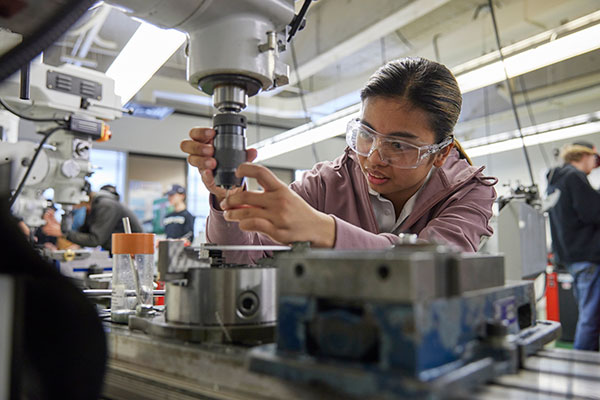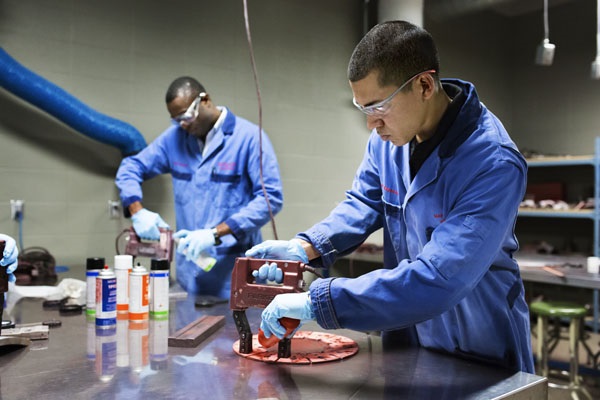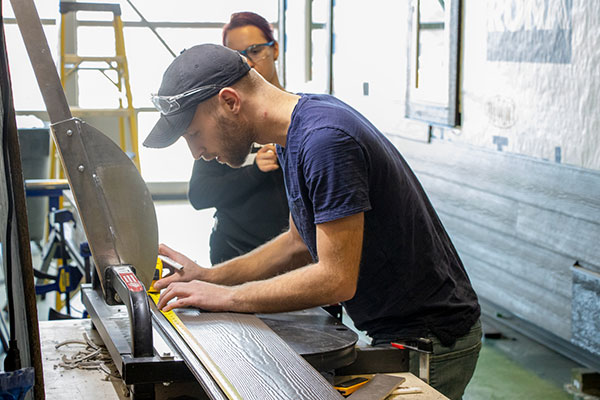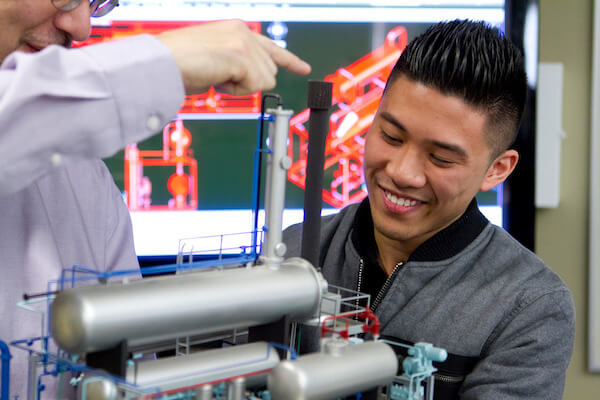Overview
Mechanical Engineering Technology is a rigorous, hands-on, two-year diploma program designed to equip you with the technical, analytical and problem-solving skills required for a variety of dynamic careers in mechanical engineering.
This program offers a foundation in the core principles of engineering, combined with practical application and design.
The first year serves as a comprehensive introduction to the field, covering essential subjects such as:
- fundamental mathematics and science for engineering applications
- computer-aided design (CAD) to bring designs to life using industry-standard software
- specialized courses that provide a deeper understanding of mechanical engineering principles.
After successfully completing your first year, you'll choose from one of three specializations - Design and Analysis, Design and Development, or Design and Automation.
While we try to accommodate everyone's specialization preference, selection is based on academic performance in relevant courses, particularly in cases where demand for a specific major exceeds available spots.
Design and Analysis
If you are interested in designing sophisticated mechanical systems, design and analysis is for you. You will:
- learn to create complex mechanical systems and components
- study the effects of vibrations on machinery and how to mitigate them
- explore energy systems and thermodynamics, the principles governing heat, work, temperature and energy
- understand the behaviour of fluids in motion and at rest and their interaction with solids.
Design and Automation
This is for those interested in automated processes in numerous industries. In design and automation, you will:
- delve into designing complex automated systems for manufacturing and other applications
- study programmable logic controllers, IEC61131-3 languages and their applications in automation
- understand the design and operation, and apply various robotics integrations for industrial and manufacturing settings.
Design and Development
This is for you if you want to make prototypes for products and systems. In design and development, you will:
- acquire skills in creating scale models for testing design concepts
- learn rapid prototyping techniques to bring ideas to tangible forms quickly
- focus on designing products and systems for optimal human use and comfort.
Regardless of your specialization, this program prepares you for immediate employment and provides a strong foundation for further studies.

If someone had told me two years ago I would do zero-gravity research with the Canadian Space Agency and the NRC, I would probably have laughed at them.
Sam Relja (right), Supernovas founder, SAIT Mechanical Engineering Technology

Those in the mechanical engineering technology field tend to be objective, innovative and methodical.
You need:
- the ability to perceive objects in 3D by looking at 2D drawings
- sketching or drawing skills
- an aptitude for math
- the ability to solve problems and think outside the box
- writing and speaking skills
- the ability to work as part of a team with minimal supervision.
You should enjoy doing precise work, obtaining and analyzing test results, finding creative solutions to problems, and taking a methodical approach to your work.
You'll participate in a capstone project where you'll work in teams to address a real-world challenge. In some cases, this project will include an industry partner.
This program is nationally accredited by Technology Accreditation Canada (TAC).
Graduates may apply for their Certified Engineering Technologist (CET) designation after two years of appropriate work experience.
While attending SAIT, you can become members of the following societies:
- Association of Science and Engineering Technology Professionals (ASET)
- Society of Automotive Engineers (SAE)
- American Society for Quality (ASQ)
After successfully completing this program, you'll receive a SAIT Mechanical Engineering Technology diploma.
Careers and opportunities
Each year, SAIT conducts a survey between February and April to determine the employment rate, salary and satisfaction of our newest SAIT alumni.
![]() 92% graduate employment rate
92% graduate employment rate
![]() $60,000 average starting salary
$60,000 average starting salary
Find out more about our graduate employment statistics >
Our graduates may work in the following occupations. Some careers require additional experience and education.
Associated National Occupational Classification (NOC) codes: 22301, 22302, 22212, 90010.

Career planning support
Unsure which career path is for you? Here are some recommended career planning resources to help you decide your future.
You can also head to Alberta alis for lots of information about careers in Alberta, including quizzes and labour market information to help you narrow down a path.
Finally, you can take our online career finder quiz, which can help narrow your options based on your current skills and interests.
Courses
The Mechanical Engineering Technology diploma requires 60 credits (24 courses) to complete.
The program spans two years, with two semesters each year.
| Course | Credits |
|---|---|
|
Professional Communication and Presentation Skills will introduce learners to the professional writing, collaboration and presentation skills needed to be successful in their chosen field. Learners will gain an understanding of the strategies and competencies required for effective communication with an emphasis on developing the interpersonal skills needed to perform as part of a high-functioning team. Coursework will require learners to work in individual and collaborative settings. Equivalents:
|
3 |
|
This applied computer course provides students with critical electronic communications, data and file management skills, along with a strong focus on using common productivity applications to format, calculate, analyze, visualize, and present or report data and information. Industry standard project management principles are implemented throughout the course from a digital perspective, so students can have an appreciation for how computing skills relate to real world business processes. |
3 |
|
Machine design analysis will be practiced for members under static and fatigue loading based on the relevant theory of failure and design criteria. Students will study the rules involved in traditional machine design details. Cross-referenced to the National Technology Benchmarks (NTB). Pre-requisites:
|
3 |
|
In this course, you will explore the kinematics of objects in translation and rotation. Velocities of objects in plane motion using both the relative velocity equation method and the instantaneous centre of rotation method will also be covered. In addition, kinetics of objects in translation, rotation, and plane motion using both Newton's second law and conservation of energy methods will be explained. |
1.5 |
|
An introduction to economic problem solving and decision-making in industry. The learner will be able to perform feasibility studies for projects considering time value of money utilizing the fundamental concepts of engineering economics. Cross-referenced to the National Technology Benchmarks (NTB). |
1.5 |
|
This course examines the classification, structure, properties, application and selection of common materials used in engineering applications. Material examples from each of the most common categories (ferrous alloys, non-ferrous alloys, polymers, ceramics and composites) will be examined. Other topics include casting and working of metals, heat treatment, effect of microstructure on properties, corrosion and failure analysis. Cross-referenced to the National Technology Benchmarks (NTB). Equivalents:
|
3 |
|
Members subjected to various loading conditions (axial, shear, torsion, transverse and combined) will be designed to perform safely, based on regulating bodies and industry practices. Stress concentration factors at geometry discontinuities will be applied and strength and deformation criteria of design will be used. Structural components will be analyzed for combined stress states including stress and strain transformation. Basic design of pressure vessels and the basic requirements of ASME code will be addressed. Critical loads in columns will be determined. Introduction to experimental stress analysis and to FEA for stress analysis and computer simulation will be addressed. Cross-referenced to the National Technology Benchmarks (NTB). Pre-requisites:
Equivalents:
|
3 |
|
By using industry standard 3-D modeling software the learner will create, analyze and communicate their designs. The models created will be analyzed for mechanical strength and optimization as well as for the sustainability of the materials chosen. The learner will generate 2-D drawings that comply with industry standards and norms to communicate their ideas. Cross-referenced to the National Technology Benchmarks (NTB). Pre-requisites:
|
3 |
|
FLDS 320 is an introductory course into the design and function of hydraulic and pneumatic components and systems. The learning activities include theory, design and practical laboratory exercises for fluid power systems and circuits used in industry. Cross-referenced to the National Technology Benchmarks (NTB). Pre-requisites:
Equivalents:
|
1.5 |
|
This course enables the student to apply the basic knowledge of algebra and introductory calculus to resolve applied scientific and technological problems. Applications include linear motion, areas under curves, and volumes of revolution. Equivalents:
|
3 |
|
This course enables the student to apply advanced algebra, integral and differential calculus methodologies to scientific and technological applications. Topics include trigonometric and transcendental calculus, methods of integration, specifically integration by parts, by trigonometric substitution, and by use of tables. Applications include linear motion, areas under curves, volumes of revolution, centroids, moments of inertia, and program-relevant applications. Pre-requisites:
Equivalents:
|
3 |
|
This design course introduces the basic building blocks required for the common core and the three specializations. Using wide-ranging, flexible design reasoning the learner will learn how to set up problems based on a good understanding of the underlying principles, choose a plan to solve them, and present the results. Cross-referenced to the National Technology Benchmarks (NTB). Equivalents:
|
3 |
|
This course examines the complex inter-relationship between technology and society. More specifically, this course frames the designation of Engineering Technologist in relation to pre-industrial and post-industrial societies in the contemporary building environment. Beginning with historical roots, this course will explain the technologist's role in developing technologies through exploration of career options, case studies and real world examples, such as field trips and current events. |
1.5 |
|
Electro-mechanical Systems is an introductory course to the world of automation for manufacturing. The course includes theory and lab activities involving pneumatic, electrical, electro-pneumatic, robotics, and computer control applications. The course design is for the beginner who is new to the various control systems and will benefit all Mechanical Engineering Technologists in the workplace as many companies adopt automation for sustainable growth of evolving and competitive manufacturing industries. Cross-referenced to the National Technology Benchmarks (NTB). |
3 |
|
The purpose of this course is to examine the different manufacturing systems and manufacturing processes used in industry. The course also includes measurement and inspection as well as surface treatment and finishing processes. Cross-referenced to the National Technology Benchmarks (NTB). |
3 |
|
The purpose of this course is to examine the fundamentals of design for manufacturability and assembly, introduction to lean manufacturing, introduction to geometric dimensioning and tolerancing, and introduction to quality. Cross-referenced to the National Technology Benchmarks (NTB). Pre-requisites:
|
3 |
|
Conceptual and embodiment design are the two essential parts of any real world mechanical design project. In this capstone, the learner will build on their program to-date to cement their ability to generate thorough design solutions through logical, systematic thinking when confronted with difficult, vague problems. Team-based skills sets are emphasized. Cross-referenced to the National Technology Benchmarks (NTB). Pre-requisites:
|
3 |
|
STAT 245 is an introductory course in data analysis for students in engineering technology programs. Students apply techniques to organize, display, analyze and report data. Outcomes include methods of descriptive and inferential statistics. Students will be exposed to software-based methods in laboratory sessions using industry-grade data. Some advanced topics of analysis are selectable toward the end of the course. |
3 |
|
This course covers components and resultants of vectors, two-force members, free-body diagrams, equations of equilibrium, equilibrium of concurrent force systems and pulley systems, moments and couples, equilibrium of non concurrent force systems, truss analysis using method of joints and method of sections, and frame analysis using method of members. Equivalents:
|
1.5 |
|
The study of energy in its many forms involves thermodynamic principles. Basic concepts of work, heat, flow and non-flow systems, and equations of state, perfect gases and properties of pure substances. The first law of thermodynamics is applied to practical systems like compressors, turbines, nozzles and other practical system to implement the concept of energy conversion. Basic power cycles will be analyzed and the performance merit to be determined. The various modes of heat transfer will be practiced and applied to simple situations. Cross-referenced to the National Technology Benchmarks (NTB). |
1.5 |
You will complete one of the following course groups depending on your specialization.
Design and analysis
| Course | Credits |
|---|---|
|
In Mechanical System Design, the learner will explore the concepts of renewable energy resources and their utilization in green and efficient Heating, Ventilation and Air-Conditioning (HVAC) systems. The learner will design simple systems for power generation, and complete simple HVAC systems for buildings by selecting the type and size of the proper equipment based on heating/cooling loads. The learners will practice project management concepts and conduct a life cycle cost analysis as part of their work. Pre-requisites:
Equivalents:
|
3 |
|
The learner will study fluid mechanics that support Manufacturing and Mechanical Engineering. The learner will explore fluid properties, fluid statics and dynamics, fluid flow and friction losses, pumps and fluid systems application in industry, infrastructure and utilities. Cross-referenced to the National Technology Benchmarks (NTB). Pre-requisites:
|
1.5 |
|
Dynamic modeling and analysis of vibrating systems deals with free and forced vibrations with and without damping in translational and rotational motion. You will study practical applications and design to control the vibrational behavior of mechanical systems, focusing on the fundamental concepts of vibration analysis in mechanical systems. Applications include vibration isolation, whirling and balancing of shafts and offset loads in machinery. You will have the opportunity to practice vibrations measurement, monitoring, testing and processing vibrational data. Pre-requisites:
|
1.5 |
|
The course focuses on power cycles for heat engines and power generation considering parameters leading to efficiency and performance enhancement and engine modification. Cycles used for refrigeration and heat pumps are to be analyzed and performance evaluated. Concepts of Psychrometry are applied. The modes of heat transfer are analyzed considering conduction and convection in plane walls, pipes and radiation. Application to the thermodynamic design of various types of heat exchangers is to be practiced. Cross-referenced to the National Technology Benchmarks (NTB). Pre-requisites:
Equivalents:
|
3 |
Design and automation
| Course | Credits |
|---|---|
|
Control Systems is a second level automation course. The learner will have the opportunity to develop fundamental skills in Boolean arithmetic, PLC programming, and Electrical/Electronic fabrication skills. Cross-referenced to the National Technology Benchmarks (NTB). Pre-requisites:
|
3 |
|
Industry 4.0 (or "Internet of Things") is a new global standard impacting Manufacturing and Automation, guiding the development of "smart factories" where the physical, virtual, and communications systems are all tightly intertwined. In this course, students will be exposed to the basic elements of Industry 4.0 including machine simulations, information gathering, presenting devices, and networking fundamentals. Pre-requisites:
Corequsites:
|
1.5 |
|
Robots and Robotics covers programming and operating several forms of industrial robotics and applying them to applications involving manufacturing, logistics, and research. The course is designed for the Design and Automation Mechanical Engineering Technologist who is interested in making machines and robots work independently and together for coordinated processes. Cross-referenced to the National Technology Benchmarks (NTD). Corequsites:
Equivalents:
|
1.5 |
|
Advanced Programmable Logic Controllers (PLCs) includes practical troubleshooting, theory and lab activities using PLCs to build and commission manufacturing machines. The course is designed for the Design and Automation Mechanical Engineering Technologist who is interested in making machines work together for coordinated manufacturing processes. Cross-referenced to the National Technology Benchmarks (NTB). Pre-requisites:
One of:
|
3 |
Design and development
| Course | Credits |
|---|---|
|
Product Development introduces the learner to the product development process. The learner will exercise concepts of technical and social functionality, including: functional constraints, end user data and manufacturability. The learner will apply the design process with practical applications through innovative hands-on projects. Projects will help the learner build proficiency in design methodologies including: problem definition, concept generation, ergonomics, applying design and material constraints. An emphasis will be placed on visual and written communication. Cross-referenced to the National Technology Benchmarks (NTB). Pre-requisites:
|
3 |
|
In the Model Making and Prototyping course the learner practices the hand skills needed to provide the differing models and prototypes required at the various development stages of product development. The learner will apply basic shop techniques and principles to create physical models and prototypes. Pre-requisites:
Corequsites:
Equivalents:
|
1.5 |
|
In Applied Product Development, the learner will develop skills in product development, apply ergonomic principles and test physical models or prototypes. The learner will also judge potential designs and concepts against pre-determined criteria. Cross-referenced to the National Technology Benchmarks (NTB). Pre-requisites:
Corequsites:
Equivalents:
|
1.5 |
|
Digital simulation allows the learner to simulate products during the design effort, before physical prototypes, which saves time and cost. Apart from helping to optimize designs, the learner will explore how simulations can streamline data and documentation generation. The learner will also use simulations as redesign departures and for rich product visualizations. Cross-referenced to the National Technology Benchmarks (NTB). Pre-requisites:
|
3 |
Progression
You must attain a PGPA and/or a CGPA of 2.0 or better each semester and pass the prerequisite courses to progress through the program.
To qualify for graduation, you must pass all courses, attain a CGPA of 2.0 or better and complete course requirements within the prescribed timelines.
Review our grading and progression procedure >

Explore your options!
Some courses in this program are available through Open Studies. You can complete courses via Open Studies to get a head start on your education, reduce your course load once accepted into a credentialed program, or determine which career path best suits you before you fully commit.
You may also take courses for general interest or personal and professional development.
Admission requirements
Applicants educated in Canada
Applicants must demonstrate English language proficiency and completion of the following courses or equivalents:
- at least 60% in Math 30-1 or at least 75% in Math 30-2, and
- at least 60% in English Language Arts 30-1 or English Language Arts 30-2, and
- at least 60% in Physics 20 and Chemistry 20 or at least 60% in Science 30.
SAIT accepts high school course equivalents for admission for applicants educated outside of Alberta.
All applicants who were educated outside of Canada must demonstrate English language proficiency and provide proof they meet the program admission requirements outlined above with an international document assessment. Find accepted educational documents and assessment options.
SAIT may also accept courses completed at certain international post-secondary institutions.

Academic Upgrading
Missing an admission requirement for this program? Upgrade your prior education to help you receive admission into one of SAIT's career programs.

English language proficiency
All applicants must demonstrate English language proficiency prior to admission, including students educated in Canada.
Transfer agreements
At SAIT, we have created transfer agreements with partner institutions to allow you to earn course credits toward your SAIT program based on your previously completed credentials.
Transfer Alberta search tool
Use the Transfer Alberta search tool to see all transfer agreements between Alberta post-secondary institutions (including those with the University of Calgary, Mount Royal University and Bow Valley College.)
Search transfer agreements in Alberta
Transfer options for graduates
When you have completed this program, you may continue your education at a partner post-secondary institution. These transfer agreements include partnerships within and/or outside of Canada.
Credits this program transfers to
- Available credits:
- 60 credits
Upon successful completion of this program, you may be eligible to apply for a post-diploma program, which may offer you - a qualified engineering technology graduate from an accredited Canadian technology program - the opportunity to obtain an engineering degree.
The post-diploma programs consist of two years of full-time study preceded by four transition courses taken during July and August.
For more information, please contact The Faculty of Engineering at Lakehead University.
- Available credits:
- 60
Graduates of this program are eligible to apply for the Mechanical Engineering bridge program offered by Camosun College, provided all admission requirements are met.
Successful completion of this bridging program will qualify you to enter the third year of the Bachelor of Applied Science in Mechanical Engineering at the University of British Columbia at either the Vancouver or Okanagan campus. This degree is eligible for Professional Engineering (P.Eng.) designation.
- Available credits:
- 31
Upon successful completion of this program, you'll be eligible to apply for admission into the University of Wyoming's Bachelor of Science in Mechanical Engineering and receive up to 31 transfer credits toward the degree.
- Available credits:
- 27
Upon successful completion of this program, you can receive 27 credits towards the 123 credits required to earn your Bachelor of Science - Energy Engineering degree at the University of Calgary, provided you meet the admission requirements.
- Available credits:
- 60
Upon successful completion of this program, you can ladder into the third year of TRU's Open Learning Bachelor of Technology program, provided you meet the admission requirements.
- Available credits:
- 60
Upon successful completion of this program, you can ladder into the third year of TRU's Open Learning Bachelor of Technology: Trades and Technology Leadership program, provided you meet the admission requirements.
Available intakes
Fall 2026
Start dates:
- Domestic students: Open
-
-
Application deadline: June 30, 2026
-
- International students: Open
-
-
Application deadline: May 29, 2026
-
Costs
2025/26 tuition and fees
The following estimated costs are effective as of July 1, 2025.
The estimated total cost of tuition and fees is based on the suggested schedule of study. Following a modified schedule will impact the fees you pay per semester and may alter final costs.
Domestic students
The program total is based on the estimated amount you will pay if you enter this program during the 2025/26 academic year. The program total amount listed on your letter of admission may appear higher. This amount is your maximum tuition guarantee for the program. SAIT will not exceed this maximum, regardless of changes in tuition and fees between academic years.
Books and supplies are approximately $1,500 per full-time year.
Find your booklist on the SAIT Bookstore's website. The booklist will be available closer to the program start date. Can't find your program or course? The bookstore didn't receive a textbook list. Contact your program directly to determine if they're still refining course details or if you're in luck; no textbook purchase is required this term.
This is a bring-your-own-device program with a custom computer hardware and software requirement.
The preferred hardware requirements for this program are as follows:
- Intel i7 (gen 7 or newer or AMD Ryzen 7)
- 16 GB RAM or greater
- 1 TB HD or greater
- Nvidia Quadro or AMD Radeon Pro video card
- Windows 10 PC (build 1906 or higher)
There is also required software, including SolidWorks.
During the program, you will use industry-standard software. Although the minimum specification will work, we recommend the best computer you can afford.
Required equipment/tools
The required tools will be provided.
Required personal protective equipment (PPE)
Safety glasses are required on the first day of class.

Financial aid
Paying for your education may feel overwhelming, but we have resources and programs that can help, including information about payment options, student loans, grants and scholarships.
Application process
When applying in the application portal, select Mechanical Engineering Technology. You will declare your major before your second year of the program.
Ready to apply?
Follow our step-by-step guide to submitting a successful application.
Communication during admission
Email is the primary source of communication during the selection process. Ensure your personal email account is managed appropriately to receive our emails, files and communications. We recommend you add the ma.info@sait.ca domain to your safe senders' list or you risk missing critical email messages.

Begin your application
Apply now using the online application portal.
Ensure you have a valid Visa or Mastercard to pay the non-refundable application fee of $120 for domestic applicants or $175 for international applicants.
Information sessions
Prepare for a strong start in your chosen program or get the details you need to decide your future path.
Our expert staff and faculty are ready to answer your questions and provide information about the following:
- What sets SAIT apart
- An introduction to the program and area of study
- Admission requirements
- Future career paths
- Information on the earning potential and graduate employment rates.
Contact us
School of Manufacturing and Automation Advising
-
Phone - 403.284.8641
-
Email - ma.info@sait.ca
International Student Advising
-
Phone - 403.284.8852
-
Email - international@sait.ca
Subscribe for updates
Your journey starts here! Sign up to get important updates on:
- Manufacturing and automation programs
- Application information
- Relevant news and events

Oki, Âba wathtech, Danit'ada, Tawnshi, Hello.
SAIT is located on the traditional territories of the Niitsitapi (Blackfoot) and the people of Treaty 7 which includes the Siksika, the Piikani, the Kainai, the Tsuut’ina and the Îyârhe Nakoda of Bearspaw, Chiniki and Goodstoney.
We are situated in an area the Blackfoot tribes traditionally called Moh’kinsstis, where the Bow River meets the Elbow River. We now call it the city of Calgary, which is also home to the Métis Nation of Alberta.




